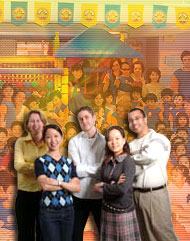Total Physical Response (TPR) is a method of teaching with the goal of helping children acquiring a second language. It was developed by Mr. James Asher in the 1960s, The main idea is that a second language can be learned in the same way and through the same natural processes as the first. TPR is based on the coordination of language and physical movement. In TPR, instructors give commands to children in the target language, and children respond with whole-body actions and vice-versa.
This method is particularly popular when teaching children or beginners.
ESL activities with TPR are tremendous fun for children and in particular for children because they are less self-conscious about moving their bodies around the classroom. A positive environment and a low level of stress are mandatory for TPR.
Activities with TPR are also great for kinesthetic learners who need more action or hands-on activities, which brings out something we call muscle memory. It involves the right hemisphere of the brain in the language learning process.
Here are some popular examples of TPR:
Simon Says (advanced version)
This is a classic among TPR activities, one that is more commonly used to teach the parts of the body. But why not go beyond the simple, “Simon says touch your nose” and try more complex commands? Say you are teaching your children how to give directions. Clear up a space in the classroom, one your children can easily maneuver around. Your commands could be directions: “Simon says turn right, Simon says go straight ahead.” Create a mini neighborhood! Place a flashcard or picture on each of your children’ desks: a bank, a pharmacy, a shopping center, etc. Arrange the desks so they create “streets”. Children take turns giving each other directions to and from locations in their neighborhood.
Charades
Another classic game, this one is best suited to teach verbs and sports. For example, to teach sports you must first introduce each with flashcards, act out each of the sports yourself, and have children say each out loud with you. Then you divide the class into two teams. Each child must take a flashcard, picture or card with a sport written on it, and pantomime the movements involved in playing the sport so that his or her teammates can guess what it is. Encourage them to be silly or exaggerate if they have to. Teammates have to answer in complete sentences: “You are playing basketball.”
Songs
Young ESL learners love to sing songs, but if you add movement or miming, they’ll enjoy them so much more. It is, in fact, difficult for most children to sing songs while sitting absolutely still. The combination of singing and moving comes naturally to them. So, why not take advantage of this and incorporate lots of songs with movement? Songs like 'Here We Go Round the Mulberry Bush', 'The Wheels on the Bus' and 'Old MacDonald Had a Farm' are very suitable for all kinds of actions.
The biological ideas behind the pairing of linguistics with motions are that listening comes before speaking, that a low level of stress encourages beginning learners, and that involving a larger section of the brain while learning a language increases its effectively. All three are combined in Total Physical Response.
